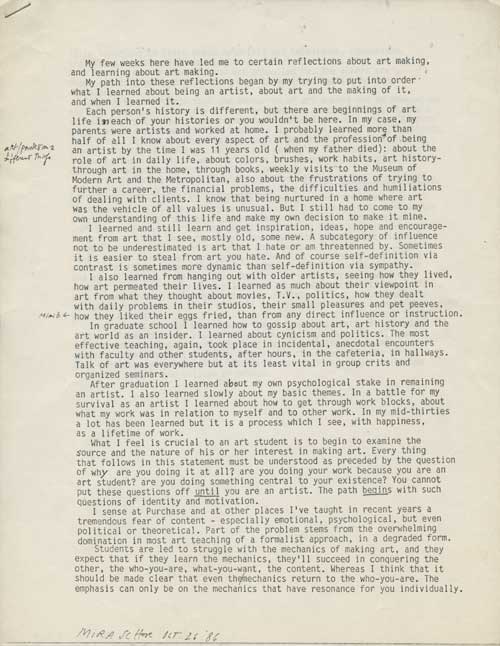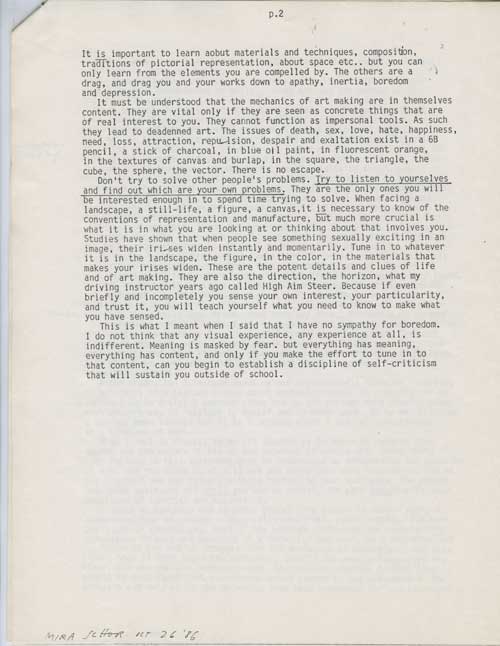In “Stephan von Huene, feminist teacher” my 2010 appreciation of my mentor at CalArts after I left the Feminist Art Program, I wrote that one of his strengths as a teacher was that “He respected the criteria by which I wished the work to be judged.” I am interested in what this means and how it might be useful in teaching today.
Looking back to that time, when I was 22 years old, I was knowledgeable enough to know what those criteria were for me at the time, in part because I was often made aware that the dominant criteria of the time were against calling what I did painting or even serious art of any kind, and because I was already by that time steeped in the artistic ideologies of the art world I had been born into and of art historical criteria as well–that is, even more than I could understand at the time, I was as committed to the values that chose to suppress me as were the gate keepers of the time.
As a teacher now, sometimes working with students with a limited background in art practice or history, I’m not sure they know the criteria that their work operates within, or, putting it differently, that they think in those terms. So the question to them might be, “What are the criteria by which you want your current work to be judged?”
In recent years I have phrased the question slightly differently: “what work of the past (and present) gives you the permission to call what you do art?” That seems to give people pause. Being in the middle of the struggle of being an art student, they apparently often hadn’t thought of it that way.
This leads to the question of what criteria (or what histories, along with their criteria) does your work summon, whether you are interested or aware of it, whether it is intentional or not. I have for example worked with students whose work was based on permissions established by the work of Ana Mendieta or Carolee Schneemann, but who reflexively rejected any association to feminist art history, even though every element of their work is based on those permissions or recalls the appearance and terms of that history and it seemed likely that their work would be judged accordingly by everyone operating in our artistic system. So then what are the criteria by which they want the work judged? I mean, are there other criteria that both the student and I are missing?
But back to my question,”What are the criteria by which you want your current work to be judged?” and turn it to “what aesthetic and ideological criteria have made your work possible, what aesthetic and ideological criteria does your work summon, whether it was your intention or not? What were or what are the debates surrounding the work that your work makes one think of, that your work looks like?” These are dynamic considerations once you open yourself up to them: if when looking at your work, a knowledgeable viewer sees something that relates to a type of art you don’t know about or a type of art you dislike and don’t want to be associated with, what does that mean about your work? How do you respond? What will going towards that antipathy do for your work?
Much work today seems determined either by easy absorption of previous art styles and types as an appearance as they exist in the floating world that is Instagram and other image-sharing platforms, or by identity politics, leaving the issues of criteria relating to everything that may not be related to that identity but are existent in the work underexamined. It may seem contradictory or ironic that I would say this given that I preferred a teacher who agreed to respect the criteria by which I wished the work to be judged but as I point out, I was working from my consciousness of an artistic context, having already observed in daily life how, for example, what let’s for brevity’s sake generalize as Greenbergian formalism was a real, determinative agent in people’s work and in their careers at that time. I looked to all the art to which I was been exposed for permissions for something I already was doing, wanted to do. And, at the same time, I began to notice that I also was very drawn to the antithetical. It has been the deep roots of the former, roots in the work I loved, and the tropism I experienced towards the Other of the latter that have moved my work forward over time, as I moved through changes in the world, in the art world, and in my own expressive needs.
All of this presumes an awareness of a field of art practice, a field I visualize as a medieval military encounter, with forces arrayed strategically. Who are those forces? Today we may operate rhizomatically rather than in the earlier stages of combative ideological positions, yet within the network there are positions that oppose each other. It is useful to have a picture and have a sense of one’s siting as any given moment.
The mechanism I describe here is also one that does not, should not end at the end of one’s schooling. Society and art change radically over one’s lifetime, so it is both essential to leave school with as deep a knowledge of the criteria one feels are relevant, as clear a picture of the field of action / the battle or points on the network)–and that field is much much more vast now than it was in the time period I was first formed as an artist. You leave with some armor for a position you can describe. Hopefully your schooling has also given you the ability and indeed the habit, the practice, of building on your initial knowledge of that field with a continued ability to be aware of the changes.
The best part of my nature is telling me that it is important to move from being aware of the parties on the field of battle of a particular moment, to being interested in one’s artistic Other, to, finally, being compassionate of that Other. Though a person who has been often been motivated by intellectual combat, literally compassionate is the word that is forcing itself into my writing about this today, starting from the point of view of a knowledgeable, stubborn, and embattled 22 year old and her compassionate teacher.
[I think Stephan would approve of my use of the word compassionate while also being aware of the irony, because both of us could be seen as feeling embattled in our lives as artists, as the years progressed and he perceived me as not just a student whose work he liked and supported but –I can’t say peer –but as someone who was saying something he respected and agreed with. In the 90s, he worked on pieces entitled What’s Wrong With Art? and What’s Wrong with Culture?]



